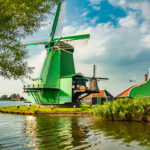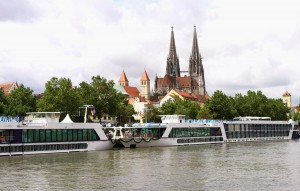The windmills of Kinderdijk are one of the most renowned Dutch tourist sites. They have been listed on the United Nations Educational, Scientific and Cultural Organization’s (UNESCO) World Heritage Sites since 1997.
 Kinderdijk is a village in the province of South Holland in the Netherlands. It is situated in a low lying area at the conflux of the Lek and Noord rivers. Around 1740, a system of 19 windmills was created in order to drain the polder (a tract of land surrounded by dikes). This particular group of windmills is the largest concentration of old windmills in the Netherlands.
Kinderdijk is a village in the province of South Holland in the Netherlands. It is situated in a low lying area at the conflux of the Lek and Noord rivers. Around 1740, a system of 19 windmills was created in order to drain the polder (a tract of land surrounded by dikes). This particular group of windmills is the largest concentration of old windmills in the Netherlands.
A traditional windmill (called windmolen) is possibly the most exemplary Dutch symbol. As you travel about the Netherlands, you can find usually one or probably two windmills dispersed in the landscape, set apart in the fields. However, you can seldom find the great sails moving, as many are no longer operational. It’s sad but true that there are only about a thousand or so windmills left in the entire country. A source claims there are about 1,150 windmills left, but the fact is that the Dutch will only “count” a windmill if it is fully operational. So, the display of several spectacular windmills, sails rotating in the wind, such as these at Kinderdijk, is indeed a sight to enthrall a tourist’s heart.
For centuries, the use of windmills to pump out excess groundwater, dikes, sluices and canals has been part of the Dutch culture and survival. The 19 remaining windmills at Kinderdijk are actually still operational, although now modern technology does most of the pumping and land reclamation throughout the modern Netherlands. But the fact remains that, for centuries, the windmills played an important role in pumping water from the polders into the canals from ground water overloads, flood waters, and, in the area nearest to the North Sea, high tide waters.
Though Kinderdijk is particularly famous for its windmills, it is also a recreational area, drawing many hikers and bikers to the miles of paths atop the hundreds of dikes in this great polder.
Your entrance ticket to Kinderdijk includes entrance to 2 windmills – Nederwaard Museum Mill and Blokweer Museum Mill; the Wisboom pumping station and a cafe with gift shop. Outside of the Blokweer Mill, is a small non-motorized barge – “Alles Heet een Tijd” built in 1914, where you can watch 3 short films. There is a 30 minute canal boat tour to show case the windmills from the water, for a small additional fee.
AmaWaterways offers 2 itineraries that visit Kinderdijk – Tulip Time with departures in March and April and Best of Holland and Belgium with departures from May to December. Check out our other Holland barge and river cruises for additional itineraries.
If you are traveling to Kinderdijk independently, there are buses from Rotterdam and Dordrecht; by waterbus from Rotterdam; or bike from Rotterdam or Dordrecht or from Kinderdijk entrance.
Call us for more information about these cruises and book one of them to see the spectacular beauty of the windmills at Kinderdijk! Europeanbarging 888-869-7907

